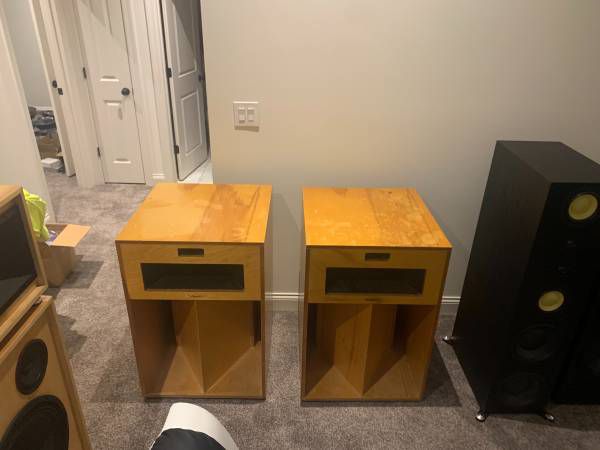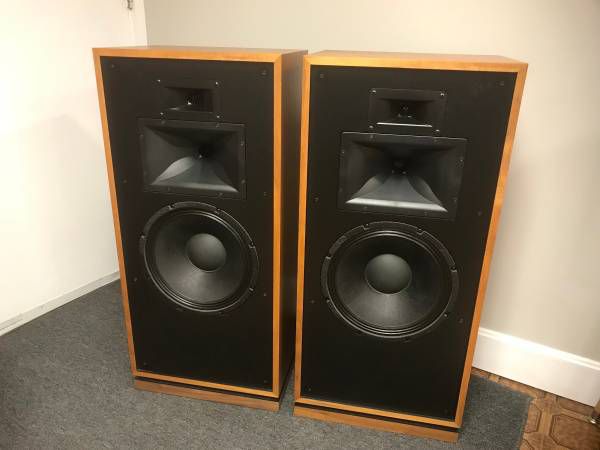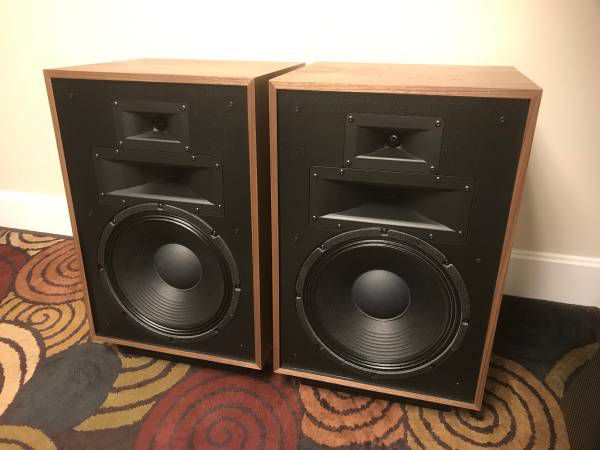-
Posts
2589 -
Joined
-
Last visited
-
Days Won
1
Content Type
Forums
Events
Gallery
Posts posted by Edgar
-
-
On 12/8/2022 at 10:50 PM, Travis In Austin said:
@Edgar please, please, please post in this thread.
Please explain what Roy does to make sure the transfer function is identical AND that the sound is identical with the replacement parts.
Please explain how in the real world manufacturers select a particular part, like in a crossover network, that goes in the end product (and I know the answer to that isn't cost alone).
Sorry, Travis, I've been offline for the past week or so, and I haven't followed this thread.
The explanation is multifaceted:
In the simplest, non-audiophile case, a designer just resorts to the math. The speaker is 8 Ohms, assumed resistive, and the crossover frequency is X Hz, so just plug the numbers into the formulas and find the values for the capacitors and inductors. Look in the catalogs for the parts that come close to the desired values at the desired prices, and specify those for production. And this, by the way, is what a lot of DIY builders do, too.
For serious audiophile situations, though, the math is just the starting point. Inductors have resistance and capacitance and hysteresis. Capacitors have resistance and inductance and dielectric nonlinearities. And, of course, loudspeaker drivers have resistance and inductance and capacitance and nonlinearities and mechanical resonances, some of which change with frequency. So the crossover (balancing network) design must take a "systems" approach -- everything affects everything else. And that interaction is the reason that simply replacing a single component with another that is nominally of the same value might affect the entire system in unexpected ways. Now, such a substitution is not likely to turn a diamond into a lump of coal, meaning that it probably won't affect the sound quality of the speaker in profound ways, but it will change it.
Most of those non-ideal characteristics can be modeled mathematically. And the resulting circuit analysis can be as complicated as the designer chooses. Ideally, the circuit is optimized such that all of the components complement each other, but even that's not the end of the story. For a stereo pair, the speakers need to complement each other, too.
And even that's not the end of the story. There is plenty of evidence that two components that measure the same can sound different. So, ultimately, the final arbiter of all of this is the listening test. Listening tests can guide us not only on the configuration of the balancing network (crossover frequencies, filter orders, individual gains), but on the types of components to use (electrolytic or film, iron-core or air-core, etc.).
And even that's not the end of the story. The real end of the story is decided by the bean-counters. Every product has a target bill-of-materials (BOM) cost. If the BOM cost is exceeded, back to the drawing board.
-
 2
2
-
 2
2
-
-
6 minutes ago, CWOReilly said:
Was in Atlanta yesterday……
Exactly how is that scam supposed to work? I take my $300 to the supposed location, and somebody hits me over the head with a baseball bat and takes my money?
-
 1
1
-
-
43 minutes ago, hanksjim1 said:
SCAM/Thief!! Same ad all over the country....
I tried to check that Atlanta ad before I posted my alert, but by then it had been deleted. Sorry for the false alarm.
-
-
-
3 minutes ago, Tom05 said:
I fully realize that it’s difficult or impossible to impress my friends , neighbors or new girlfriends , with zip cord , lamp cord , or ,cheap cord .
Snake your zip cord through a section of garden hose. Nobody will ever be the wiser.
-
 1
1
-
 1
1
-
-
1 hour ago, Racer X said:
I remember that. "2 + 2 = 5, for sufficiently large values of 2".
-
 1
1
-
-
1 minute ago, Racer X said:
In case anyone is interested in experimenting with this, the magic length is the actual wire tip to tip. The soldered connectors such as RCA plugs or spade lugs are not part of the magic dimension.
"Magic" is the only accurate description of that dimension, as in "magical thinking".
-
 1
1
-
-
On 10/24/2022 at 10:12 AM, Dave A said:
"Had my interconnect cables custom made to be 10’3.47” long…mathematically this is the perfect length as all the distortion has plenty of room to disperse."
@Dave A, research by Medwin indicates that the perfect length is actually 57 1/8th inches. Whom to believe?
Taking the myth slightly off-topic, as an engineer who specializes in DSP, I'm just waiting for somebody to claim that they can hear differences in the CPUs used to perform the arithmetic.*
*There are some architectural differences that could potentially affect the audio; fixed-point vs. floating-point, 32-bit vs 64-bit, etc. But any two processors that implement the same arithmetic in the same format will produce the same results. If they don't, then at least one of them is broken.
-
 1
1
-
-
-
-
Klipsch Palladium P38 speakers with matching P312 sub in Merlot finish.
https://stlouis.craigslist.org/ele/d/edwardsville-klipsch-palladium-speakers/7547081058.html
Unfortunately, only photos of the boxes in the ad.
No affiliation.
-
13 minutes ago, Travis In Austin said:
Meet Pedro Sanchez Delgado!!!!!
That's a lot of very long-term employees. Must be doing something right.
Also, striking difference between "Arkansas accent" and "Missouri accent". You'd never know that we're neighbors.
-
 1
1
-
-
48 minutes ago, grindstone said:
Hey where is the TOS? I just went looking and struck-out. If it's updated, I need to read it.
-
 1
1
-
 1
1
-
-
2 minutes ago, ClaudeJ1 said:
Back in my days in Automotive Electronics, the micro code was written in Assembly Language because of ROM limitations. Assembly language is one level up from computer machine language. Programming in it is like trying to run a marathon on your kneecaps with no pads!!
Yes, I've done plenty of assembly language programming. I actually like it -- the programmer has complete control over everything.
3 minutes ago, ClaudeJ1 said:Now that memory is cheap and plentiful, is seem C+ or C++, or whatever derivation exists is the darling of the coders. It's memory capacity that allows for even inefficient/sloppy code to still work because hardware is so cheap.
It's even worse than that. At least C/C++ are compiled. The language of the day seems to be Python, which is interpreted, and takes about 10x as long to run as compiled C to do the same thing. But processing power is so great that few people care, or even notice.
-
 2
2
-
-
6 minutes ago, ClaudeJ1 said:
We do have amazing tools to work with. I have a 1904 Zeiss catalog that talks about Planar an Tessar lenses. They are still being made today, with derivations, using newer glass formulas and a billion ray traces/second in simulation.
In 1993 I developed a signal processing technique that is so computationally-intensive that I thought I would never see it run in real-time during my lifetime. By about 2010 it could run in real-time on a telephone. It's an amazing time to be an engineer.
-
 4
4
-
-
43 minutes ago, avguytx said:
Audiokarma.
https://audiokarma.org/forums/index.php?forums/the-klipsch-korner.131/
-
 2
2
-
 1
1
-
-
7 minutes ago, ClaudeJ1 said:
How about the blending of passive networks' roll-off characteristic in conjunction with the acoustic roll-off of a horn coupled with different driver characteristics, including the impedance peak?
Well, you can Zobel an impedance peak https://community.klipsch.com/index.php?/topic/187697-measurement-systems/&do=findComment&comment=2436802. As for the rest, I can usually model horn response and driver response, and compensate for them, in DSP, unless they're really unusual.
-
 1
1
-
-
2 minutes ago, deang said:
I called all of these people earlier today and they denied knowing either of you.
The pitfalls of keeping a low profile.
-
 1
1
-
-
24 minutes ago, ClaudeJ1 said:
I think I already named one of them.
Again, I don't want to name any names, but at least a few of them have tried to participate in various audio forums and been thrown-off of them, either for blatant commercial self-promotion or for rudeness to other members.
-
@ClaudeJ1, you and I have had the privilege of rubbing elbows with some heavy-hitters in this (and other) industries. Some of them, like Roy, are down-to-earth country boys who will take you fishin' in the morning and then dig deep into the tech in the afternoon. Others, who shall remain nameless, can be real prima donnas who will berate you for asking the time of day. I guess it's the same everywhere.
-
 4
4
-
-
8 minutes ago, ClaudeJ1 said:
I communicated with Dr. Floyd Tool about 3 years ago. He said Harman owns the patents on CBT's and let Don propagate the technology (probably needed the money).
Free advertising.
8 minutes ago, ClaudeJ1 said:I read somewhere that Don officially retired, so I hope he's sipping fruity drinks on an island somewhere or playing golf, who knows.
He's retired and living in picturesque Bloomington, Indiana. He's almost 82, now, so slowing-down a bit. Don's Website
10 minutes ago, ClaudeJ1 said:Having owned 3 pairs of Roy's K-402's in the last 10 years (still have a pair) I can detect Zero horn artifacts on that one either.
I think that the world has finally figured out that horns don't have to sound like "horns" if they're designed properly. Modern computational power and finite element analysis have made that possible. 3D printing has made prototyping much easier.
-
 1
1
-
-
15 minutes ago, ClaudeJ1 said:
I had lunch with Don, back in 2014. We talked about his current designs mostly, but he did say that he could have designed some new horns for Klilpsch, but PWK wouldn't let him for some reason. IDK.
I corresponded with Don as recently as last December, then he suddenly stopped responding. I don't know whether there is a health problem, or some other pressing matter.
-
1 minute ago, ClaudeJ1 said:
If you read "What's so sacred about exponential horns" by Don Keele (who apparently did not get along well with PWK when he worked there). The idea of hybrids happened during his time at Electro Voice under Ray Newman's leadership. I have met all 4 of these gentlemen at on time or another since 1976 (also Saul Marantz as a 5th). Great evolution of the ART and science!
Yes, I'm familiar with that paper by Don Keele. (And with Don Keele himself. I worked with Don at Electro-Voice, and got along with him just great. That's part of the reason that I wonder if PWK and I would have gotten along -- I think that we would have either "clicked" or hated each other's guts.)







Power Tube Prices
in Talkin' Tubes
Posted
https://www.tubesandmore.com/search/node/kt77/